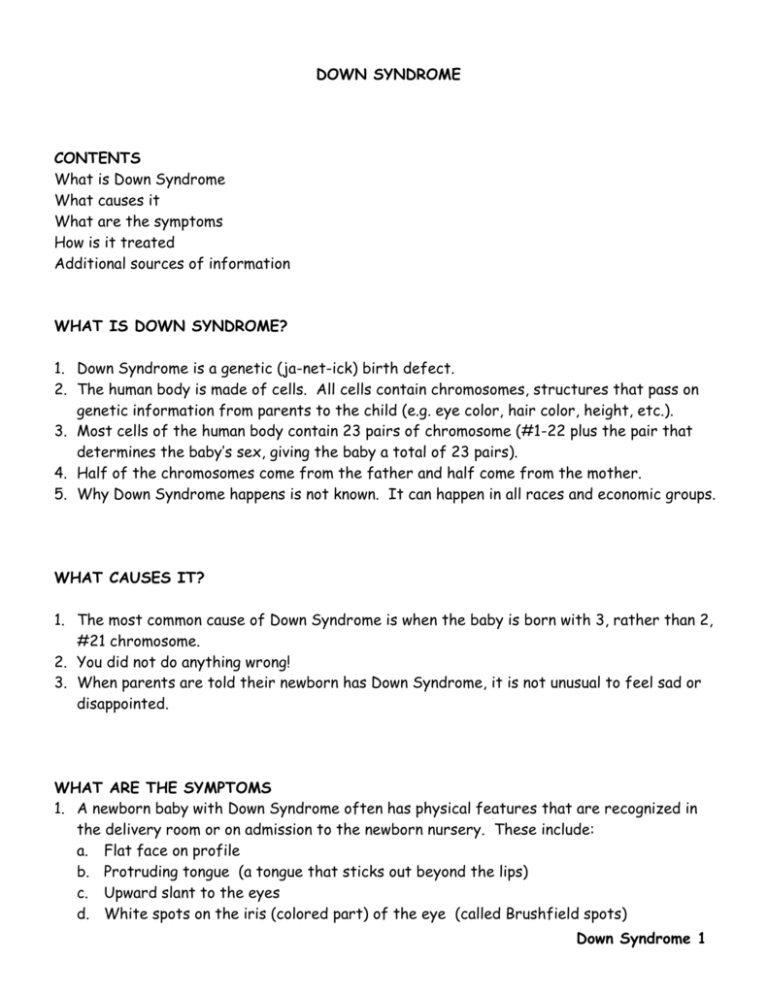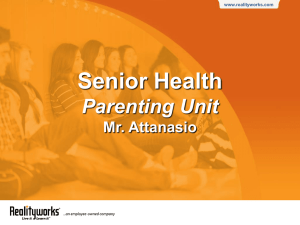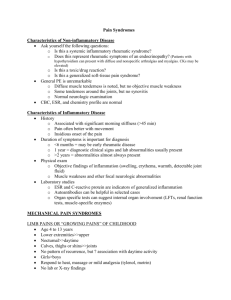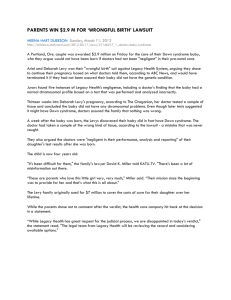Down Syndrome - Mother Baby University
advertisement

DOWN SYNDROME CONTENTS What is Down Syndrome What causes it What are the symptoms How is it treated Additional sources of information WHAT IS DOWN SYNDROME? 1. Down Syndrome is a genetic (ja-net-ick) birth defect. 2. The human body is made of cells. All cells contain chromosomes, structures that pass on genetic information from parents to the child (e.g. eye color, hair color, height, etc.). 3. Most cells of the human body contain 23 pairs of chromosome (#1-22 plus the pair that determines the baby’s sex, giving the baby a total of 23 pairs). 4. Half of the chromosomes come from the father and half come from the mother. 5. Why Down Syndrome happens is not known. It can happen in all races and economic groups. WHAT CAUSES IT? 1. The most common cause of Down Syndrome is when the baby is born with 3, rather than 2, #21 chromosome. 2. You did not do anything wrong! 3. When parents are told their newborn has Down Syndrome, it is not unusual to feel sad or disappointed. WHAT ARE THE SYMPTOMS 1. A newborn baby with Down Syndrome often has physical features that are recognized in the delivery room or on admission to the newborn nursery. These include: a. Flat face on profile b. Protruding tongue (a tongue that sticks out beyond the lips) c. Upward slant to the eyes d. White spots on the iris (colored part) of the eye (called Brushfield spots) Down Syndrome 1 e. Abnormally shaped ears f. Short neck g. Fat pad a the back of the neck h. A single deep crease on the palm of the hand i. Poor muscle tone (hypotonia) j. Take longer than usual to finish a feeding k. Constipation 2. Other associated medical problems may include: a. Disturbances with the thyroid gland b. Increase in infections such as ear infections and tonsillitis c. Hearing loss d. Visual changes e. Congenital heart defects 3. Not all babies have all of the symptoms; some babies will have only a few of the symptoms. It varies from baby to baby. 4. Your baby’s doctor will talk with you about his/her finding. Please feel free to ask questions. HOW IS IT TREATED 1. Babies with Down Syndrome should have regular, well-baby care that all children receive. 2. Treatment is based on the baby’s symptoms and varies from baby to baby. 3. To confirm the diagnosis of Down Syndrome, the baby’s doctor will order a blood test called a chromosomal karyotype (carry-o-type). It takes about 2-3 weeks to get the results. 4. Once the diagnosis has been confirmed, the doctor will talk with you about your baby. 5. Children and adults with Down Syndrome have a wide variety of abilities as well as limitations. A person with Down Syndrome may be very healthy or may have medical problems. Again, your baby’s doctor is the best source of information. 6. Every person with Down Syndrome is a unique individual and not every person with Down Syndrome develops problems. Down Syndrome 2 ADDITIONAL SOURCES OF INFORMATION The following organizations can provide you with additional information. This is only a partial list but is a good place to start. Again, talk with your baby’s doctor, he may have additional sources available. 1. National Down Syndrome Society 666 Broadway New York, NY 10012 1-800-221-4602 (212) 460-9330 http://www.ndss.org/ 2. National Down Syndrome Congress 1370 Center Drive, Suite 102 Atlanta, GA 1-800-232-6372 (770) 604-9500 http://www.ndsccenter.org/ 3. March of Dimes 1275 Mamaroneck Avenue White Plains, NY 10605 (914) 997-4488 1-888-MODIMES (1-800-663-4637) http://wwwmodimes.org/ Reviewed/Revised: 2/04, 6/05, 4/07, 1/10 Down Syndrome 3







